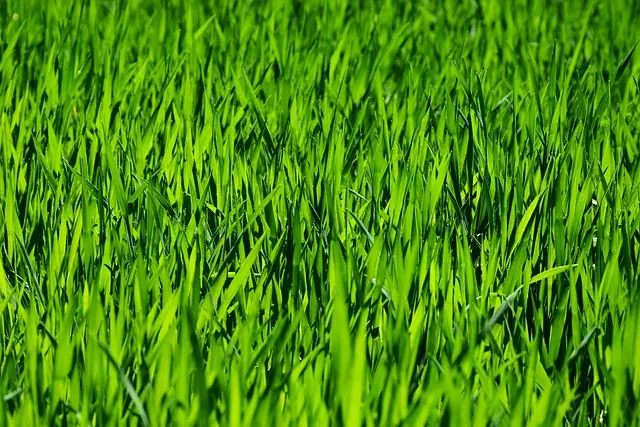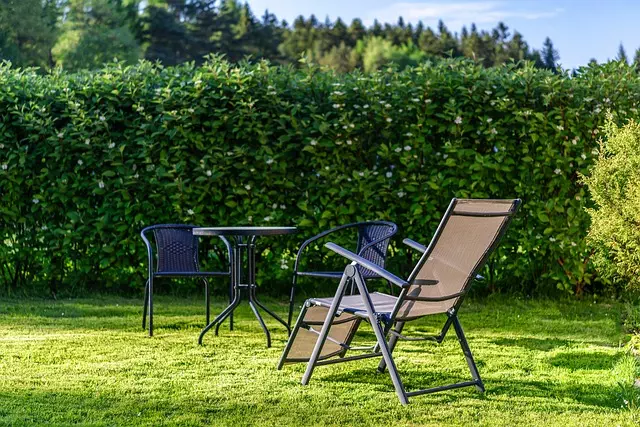Lawn care and landscaping are integral to creating a visually appealing and functional outdoor space. A robust lawn care regimen includes optimal mowing, aeration, targeted irrigation, and species-specific fertilization to maintain a healthy turf. Pest management and disease prevention are also crucial for protecting the lawn's aesthetic and health. Seasonal adjustments in lawn care practices are necessary to adapt to changing weather conditions and local soil variations. Incorporating a diverse array of plants and hardscaping elements can create a cohesive landscape that complements the turf and adds depth to the outdoor environment. Using native plants, strategic plant placement, mulch, and landscape fabric promotes low-maintenance landscapes that are both beautiful and conducive to biodiversity. Hardscaping features like pathways, retaining walls, and water features enhance the functionality of the space while aligning with sustainable practices by reducing lawn size and conserving water. Advanced Water Management Systems tailored with smart controllers and weather-based sensors ensure efficient irrigation, minimizing water waste and promoting environmental responsibility. Year-round maintenance, including fertilization, weed control, aeration, and seasonal planting, keeps the landscape vibrant and resilient, adding to the overall curb appeal and ensuring a healthy outdoor space throughout the year.
Embarking on a landscaping project can transform your outdoor space into a serene sanctuary or a vibrant haven. This article delves into the art and science of lawn care and landscaping design, guiding you through the essentials of creating a thriving landscape. From assessing your property’s unique characteristics to selecting and placing plants with precision, each section offers practical insights. Discover how innovative hardscaping can elevate your outdoor area’s functionality and aesthetics, while also learning about sustainable water management systems that ensure your lawn stays lush throughout the seasons. Whether you’re a beginner or an experienced gardener, this comprehensive guide provides valuable tips for maintaining your landscape year-round, ensuring it remains both beautiful and healthy.
- Understanding the Fundamentals of Lawn Care in Landscape Design
- Assessing Your Property for Optimal Landscape Potential
- Crafting a Cohesive Garden Plan: Plant Selection and Placement Strategies
- Innovative Hardscaping Elements to Elevate Your Outdoor Space
- Implementing Water Management Systems for Sustainable Lawn Care
- Maintenance and Seasonal Upkeep to Maintain a Vibrant Landscape Year-Round
Understanding the Fundamentals of Lawn Care in Landscape Design

A well-maintained lawn serves as a foundational element in landscape design, enhancing both the aesthetic appeal and functional aspects of an outdoor space. The fundamentals of lawn care are integral to achieving a lush, resilient turf that complements the overall design. Regular mowing at the appropriate height for the grass species promotes healthy growth by allowing sunlight to reach the base of the grass blades and encouraging root development. Aeration and proper irrigation are also critical practices; they alleviate soil compaction and ensure that water reaches the roots effectively, which is particularly important during periods of drought or extreme heat. Fertilization tailored to local soil conditions and grass types ensures nutrient availability for consistent growth and vibrant color.
Beyond these basic lawn care routines, integrating pest management and disease prevention strategies are essential to protect the turf from harmful organisms that can disrupt the intended landscape design. Understanding the local climate and seasonal variations allows for the implementation of proactive measures that safeguard against undesirable elements while fostering a healthy, thriving lawn. Additionally, incorporating a variety of plantings and hardscaping features that complement the lawn can create a harmonious and cohesive landscape design. The key to successful landscaping with a focus on lawn care lies in the consistent application of these practices and an adaptive approach that responds to changing conditions, ensuring that the lawn remains a beautiful and functional component of the overall landscape design.
Assessing Your Property for Optimal Landscape Potential

Crafting a Cohesive Garden Plan: Plant Selection and Placement Strategies

In crafting a cohesive garden plan, thoughtful plant selection and strategic placement are pivotal elements that contribute to both the aesthetic appeal and health of your landscape. Selecting plants suited to your local climate and soil conditions ensures they will thrive, reducing the need for extensive lawn care and maintenance. Consider the mature size and growth habits of each specimen to prevent overcrowding or gaps as they develop. Positioning taller, structural plants behind shorter ones creates a layered look that adds depth to your garden design. Similarly, grouping plants with similar water and sunlight needs together minimizes wasteful lawn irrigation and promotes efficient lawn care practices. Using native plants not only supports local biodiversity but also simplifies upkeep as they are already acclimated to the area’s conditions. Integrating annuals and perennials that bloom at different times extends your garden’s visual interest throughout the seasons. By incorporating these considerations into your garden plan, you can achieve a harmonious and low-maintenance outdoor space that complements your home’s landscaping and enhances your overall property value.
To further refine your garden’s aesthetic and functionality, consider the impact of seasonal changes on your plant choices. Evergreens provide year-round structure and interest, while deciduous shrubs and perennials can offer seasonal contrast and vibrancy. Edging beds with decorative stones or mulch not only sharpens the boundaries between lawn and garden but also helps to retain soil moisture, reducing the need for frequent watering and upkeep. Employing landscape fabric beneath your plantings can suppress weeds and make lawn care tasks less demanding. By thoughtfully combining these elements, you can create a thriving outdoor environment that requires less labor-intensive lawn care and more time to enjoy the beauty of your well-designed garden.
Innovative Hardscaping Elements to Elevate Your Outdoor Space

Incorporating innovative hardscaping elements into your outdoor space can significantly elevate its aesthetic appeal and functionality, offering a seamless blend of form and function that complements lawn care and landscaping efforts. Hardscaping, which includes features like paths, retaining walls, and water features, serves as the structural backbone of a landscape design. To enhance the visual interest and usability of your outdoor area, consider integrating unique paver patterns for walkways, creating an inviting seating area with decorative concrete blocks, or adding a waterfall or fountain that introduces soothing sounds and attracts wildlife. The textured surfaces of natural stone or the clean lines of precast concrete elements can provide both visual contrast and tactile interest to your landscape. Moreover, thoughtful hardscaping not only contributes to the overall design but also supports effective lawn care by defining spaces and reducing unnecessary traffic on grassy areas. Strategic placement of these features can facilitate better drainage, prevent soil erosion, and create distinct zones within your yard for different activities or plantings, thereby enhancing the overall health and appearance of your outdoor space.
Investing in high-quality hardscaping materials and designs not only elevates your property’s value but also encourages a more active and enjoyable use of your outdoor environment. Smart hardscaping choices can also support sustainable landscaping practices by minimizing lawn size and promoting the growth of diverse plant life, which requires less maintenance and conserves water. By integrating xeriscaping principles with attractive hardscape features like permeable pavers or drought-resistant native plantings, homeowners can create a low-maintenance landscape that is both aesthetically pleasing and environmentally friendly. The fusion of innovative hardscaping with traditional lawn care and landscaping practices results in an outdoor space that is both beautiful and sustainable.
Implementing Water Management Systems for Sustainable Lawn Care

Incorporating Water Management Systems into landscaping design is a pivotal strategy for sustainable lawn care. These systems are designed to optimize water usage, conserve water resources, and maintain healthy turf. By harnessing technology such as smart controllers and weather-based sensors, these systems can adapt irrigation schedules to actual plant water needs, soil moisture conditions, and local weather forecasts, thereby reducing unnecessary watering and promoting water conservation. Landscapers are increasingly integrating drip irrigation or micro-irrigation for flower beds and gardens, which delivers water directly to the roots of plants, minimizing evaporation and runoff. For lawns, rotary nozzles or pop-up sprinklers are strategically placed to cover the entire area uniformly, ensuring that each blade of grass receives the optimal amount of moisture without waste.
Moreover, the choice of grass varieties suitable for local climate conditions is another aspect of sustainable lawn care. Selecting drought-resistant grass species can significantly reduce the need for supplemental irrigation. Additionally, landscaping designs often incorporate xeriscaping elements, such as native plants and mulch, to create a low-maintenance landscape that requires less water overall. These practices not only contribute to the conservation of water but also foster a resilient and aesthetically pleasing environment. By prioritizing water management in landscaping design, homeowners and communities can ensure their lawns remain lush and vibrant while aligning with sustainable practices for years to come.
Maintenance and Seasonal Upkeep to Maintain a Vibrant Landscape Year-Round

Engaging in regular lawn care and landscaping maintenance is key to sustaining a lively and well-maintained outdoor space throughout the year. Seasonal upkeep not only enhances the visual appeal of your landscape but also promotes the health and longevity of plants, trees, and turf. In spring and summer, focus on fertilization, weed control, and consistent mowing to encourage robust growth. Aerating the lawn during this time can also alleviate soil compaction, allowing nutrients and water to reach the roots more effectively. As fall approaches, prepare your landscape for the colder months by clearing debris, cutting back perennials, and dividing overgrown plants. This preparation ensures that when winter arrives, the foundation of your landscape is protected from harsh elements, setting the stage for a vibrant rebirth in spring. Regular inspections should be conducted to monitor for any signs of disease or pest infestation, addressing issues promptly to maintain the integrity of your landscape design.
Throughout all seasons, the commitment to consistent lawn care and landscaping practices is paramount. Employing a strategic plan for irrigation, particularly during dry spells, keeps plants well-hydrated without excess. Mulching garden beds helps to retain soil moisture and suppress weeds, while also improving soil quality over time. Seasonal planting can introduce new colors and textures, creating an ever-evolving landscape that reflects the passage of time and the changing seasons. By adhering to a year-round maintenance schedule tailored to your local climate and ecosystem, you can enjoy a thriving landscape that remains both beautiful and resilient.
In conclusion, mastering lawn care and landscaping is a multifaceted endeavor that transforms your property into an outdoor haven. By meticulously assessing your space and understanding the fundamentals of lawn care within landscape design, you lay the groundwork for a thriving garden. Strategic plant selection and placement, coupled with the integration of innovative hardscaping elements, not only enhance aesthetics but also function. Implementing water management systems ensures sustainable lawn care practices. Regular maintenance and seasonal upkeep are key to maintaining a vibrant landscape that remains resilient throughout the year. Embracing these principles will elevate your outdoor space into a testament of harmony between nature and design, showcasing your commitment to lawn care and landscaping excellence.


